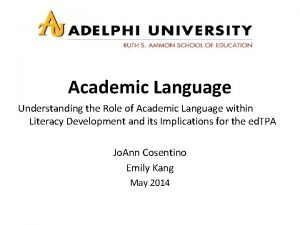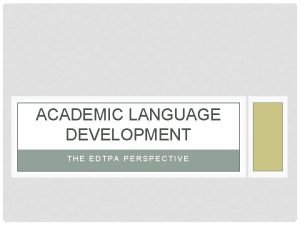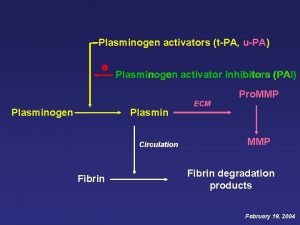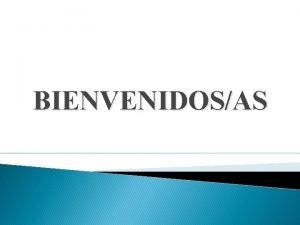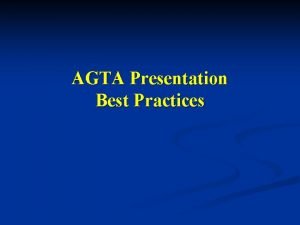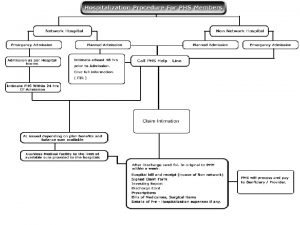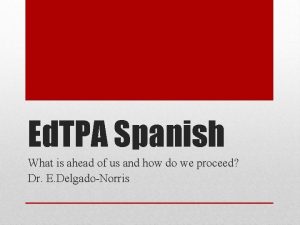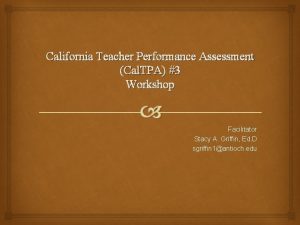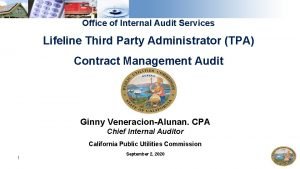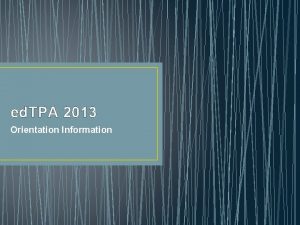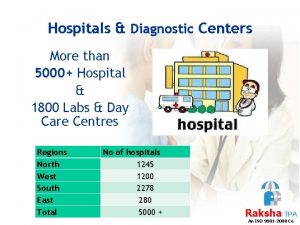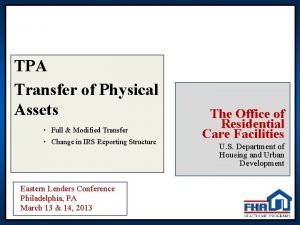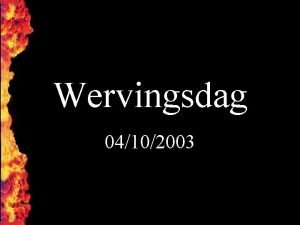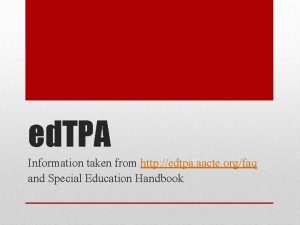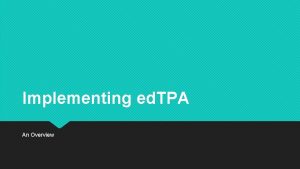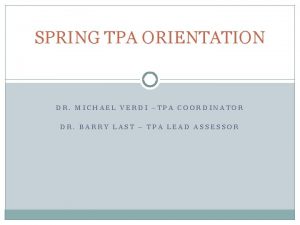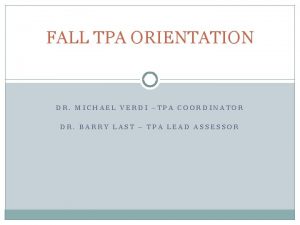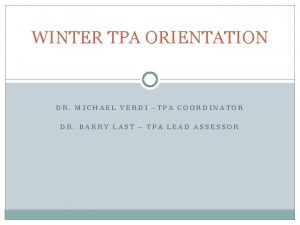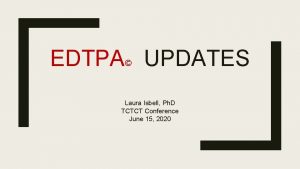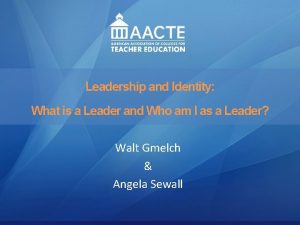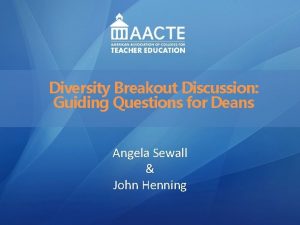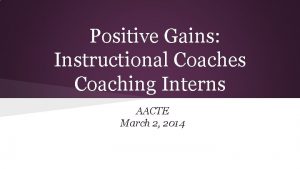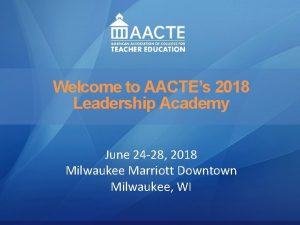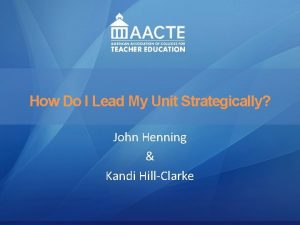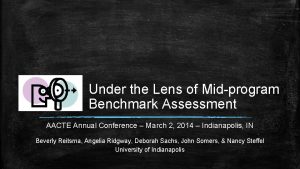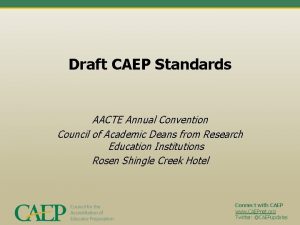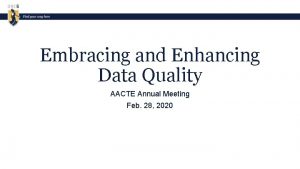ed TPA Information taken from http edtpa aacte





















- Slides: 21

ed. TPA Information taken from http: //edtpa. aacte. org/faq and Special Education Handbook

• ed. TPA is a preservice assessment process designed by educators to answer the essential question: "Is a new teacher ready for the job? " What is ed. TPA?

• Stanford University faculty and staff at the Stanford Center for Assessment, Learning, and Equity (SCALE) developed ed. TPA. • The design and review team was comprised of more than 100 university faculty, national subject -matter organization representatives (e. g. , NCTM, NCTE, NSTA, etc. ), and K-12 teachers. Who Created ed. TPA?

• ed. TPA is intended to be used for teacher licensure and to support state and national program accreditation • As a nationally available teacher performance assessment, ed. TPA: • Provides a uniform and evidence-based process that can be used across states to confirm that aspiring teachers demonstrate their readiness for the classroom. • Measures candidates' ability to differentiate instruction for diverse learners, including English language learners and special education students. • Provides meaningful and consistent data that can be used to improve teacher education programs and renew program curriculum. What is ed. TPA designed to achieve?

• Evidence of a candidate's ability to teach is drawn from a subjectspecific learning segment of 3 -5 lessons from a unit of instruction taught to one class of students. • Materials assessed include video clips of instruction, lesson plans, student work samples, analysis of student learning, and reflective commentaries. • Based on the submitted evidence, which is reviewed by trained scorers, faculty and candidates can discuss the impact of candidates' teaching performance on student learning and determine ways to improve teaching. • Faculty can analyze evidence of candidate performance to guide decision-making about program revision. • State education agencies may use ed. TPA scores for licensure and accreditation. How is ed. TPA constructed and used?

• aligns with the Interstate Teacher Assessment and Support Consortium (In. TASC) standards, and various professional standards, depending on the subject area, including Common Core State Standards and Specialized Professional Association (SPA) standards • aligns with the National Council for Accreditation of Teacher Education (NCATE) standards…provides the type of evidence NCATE seeks in determining whether or not a unit's teacher candidates have the knowledge, skills, and dispositions that are outlined in its standards. What are the standards upon which it is based?

• Stanford University is the author and exclusive owner of ed. TPA and responsible for ongoing development of the assessment, and implementation support resources for participating states and institutions of higher education. • Stanford University is also responsible for the design and development of the online scoring training, including selecting and coding subject-specific benchmarks and other training materials. What is Stanford University's role in ed. TPA?

• The American Association for Colleges of Teacher Education (AACTE) supports the development and implementation of ed. TPA and is helping to share information about ed. TPA with its member institutions What is AACTE's role in ed. TPA?

• Demand for ed. TPA grew so rapidly that support was needed to deliver it to campuses and states that asked for it. • So through a procurement procedure, Stanford chose Pearson because Pearson has the capacity, experience, and infrastructure to offer ed. TPA at scale quickly, so that students don't have to wait to see the benefits in the classroom. • As an operational partner, Pearson will deliver the assessment materials, online technology, program resources, and other support to teacher candidates that's required for multi-state use of ed. TPA program. What is Pearson's role in the implementation / rollout of ed. TPA?

• Stanford University is the exclusive author and owner of ed. TPA. Who will own ed. TPA upon completion of field-testing and final development work?

• The estimated $300 fee charged to teacher candidates for ed. TPA is fair. • That cost covers all ed. TPA assessment services, including a professional, qualified evaluator who has been trained to ed. TPA rubrics, expectations of performance, and standardized scoring procedures, and who will be monitored during scoring activities to maintain high quality. What are the costs associated with ed. TPA?

• • • Early Childhood Elementary Education Elementary Literacy Elementary Mathematics English as an Add’l Language Health Education K-12 Performing Arts K-12 Physical Education Middle Childhood English-LA Middle Childhood History/Social Studies • Middle Childhood Mathematics • Middle Childhood Science • Secondary English-Language Arts • Secondary History/Social Studies • Secondary Mathematics • Secondary Science • Special Education • Visual Arts • World Language What subjects will be available for ed. TPA?


• Candidates submit artifacts and commentaries as evidence of how they planned and implemented instruction • Artifacts represent authentic work completed by candidates and their learners. • lesson plans, copies of instructional and assessment materials or data collection procedures, video clips of teaching, and work samples • Commentaries are opportunities to describe the artifacts, explain the rationale behind their choice, and analyze what has been learned about teaching practice and its impact on learner(s). • although writing ability will not be scored directly, commentaries must be clearly written and well focused. Evidence of Teaching Practice: Artifacts and Commentaries

• 15 rubrics specific to subject area • 5 rubrics related to planning • 5 rubrics related to instruction • 5 rubrics related to assessment • Five-level rubrics address a wide range of performance representing the knowledge and skills of a novice ranging from not ready to teach (Level 1) to the advanced practices of a highly accomplished beginner (Level 5). Evaluation Criteria

• • Colorado Connecticut Delaware District of Columbia Georgia Hawaii Idaho Illinois • • Iowa Indiana Maryland Massachusetts Minnesota New York North Carolina Ohio • Oklahoma • Oregon • South Carolina • Tennessee • Virginia • Washington • Wisconsin • Wyoming Who is participating in ed. TPA?

• Initial Participants • East Carolina University • UNC Chapel Hill • Winston Salem State University • Recent Participants • • NC State UNC Greensboro UNC Asheville Western Carolina University- Go CATS! North Carolina Participants

Alisa Chapman, Vice President UNC General Administration Academic & University Programs Invitation to Participate

* Choose new Inclusive Education program to pilot first * Elementary Education choose to pilot simultaneously Original Plan of Participation

Incorporate ed. TPA into all education programs 4 Programs have committed to 1 st generation Implementation BK, Inclusive Ed, Health/PE, , and Secondary Social Sciences Current Plan of Participation

Dale Carpenter Kim Ruebel Dan Grube Renee Corbin Lee Nickles Mary Beth Decatur Myra Watson, BK Carrie Rogers, ELED Baxter Williams, MG Holly Pinter, MG & Pearson Scorer Mary Ella Engel, Social Sciences Sarah Meltzer, Secondary Other Bob Beaudet, HPE Marissa Ray, Inclusive Ed, Coord. Ed. TPA Leadership Team
 Aacte leadership academy
Aacte leadership academy What is productive language
What is productive language Language function edtpa
Language function edtpa Tpa upa
Tpa upa Rakshatpa address
Rakshatpa address Paramount tpa
Paramount tpa Ikrar tk islam
Ikrar tk islam Aul4s
Aul4s Supershuttle tampa
Supershuttle tampa Paramount health card
Paramount health card Tpa spanish
Tpa spanish Cal tpas
Cal tpas Lifeline tpa
Lifeline tpa Tpa handbook
Tpa handbook Tpa best presentation award
Tpa best presentation award Raksha tpa escalation matrix
Raksha tpa escalation matrix Modified tpa
Modified tpa Lucia malaguarnera
Lucia malaguarnera Http //mbs.meb.gov.tr/ http //www.alantercihleri.com
Http //mbs.meb.gov.tr/ http //www.alantercihleri.com Http //pelatihan tik.ung.ac.id
Http //pelatihan tik.ung.ac.id When and where was this photograph taken?
When and where was this photograph taken? 22 taken van de brandweer
22 taken van de brandweer

